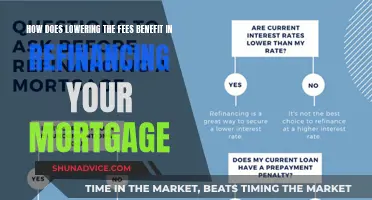
The prime rate is the interest rate that banks use to set rates for different types of loans, credit cards, and lines of credit. It is the rate that banks charge their most creditworthy customers, typically large corporations and high-net-worth individuals. The prime rate is an important element in the overall state of the economy and can impact mortgage rates, with variable-rate mortgages and home equity lines of credit (HELOCs) being directly influenced by the prime rate. When the prime rate increases, the cost of borrowing money increases, which can curb spending and growth and bring prices back in line. Conversely, a lower prime rate can encourage borrowing and spending, making homeownership more affordable. The prime rate is influenced by various factors, including inflation, recessions, economic growth, and changes in the housing market.
| Characteristics | Values |
|---|---|
| Prime rate definition | The interest rate that commercial banks charge their most creditworthy customers for loans |
| Prime rate calculation | The federal funds rate + 3% |
| Prime rate as of January 2025 | 7.50% |
| Prime rate as of December 2024 | 7.50% |
| Prime rate in June 2024 | Not mentioned |
| Highest prime rate ever recorded in the U.S. | 21.5% in December 1980 |
| Prime rate impact on mortgages | Directly impacts variable-rate mortgages and HELOCs (home equity lines of credit). Does not impact fixed-rate mortgages |
| Prime rate impact on credit cards | Directly impacts credit cards with variable interest rates |
| Prime rate impact on liquidity | High prime rate results in low liquidity and vice versa |
| Prime rate impact on the economy | High prime rate curbs spending and growth, whereas a low prime rate encourages borrowing and spending |
What You'll Learn

Prime rate and variable-rate mortgages
The prime rate is the interest rate that banks charge their most creditworthy customers. It serves as a baseline for all other interest rates charged by a financial institution. The prime rate is derived from the federal funds rate, which is the cost for federally backed banks to borrow money from each other overnight. Banks usually use the formula fed funds + 3 to calculate the prime rate.
The prime rate affects a variety of bank loans, including mortgages. Variable-rate mortgages are directly tied to lender prime rates and fluctuate with the prime rate. Variable-rate mortgages are usually stated as prime plus/minus a percentage discount/premium. For example, a variable rate could be quoted as prime - 0.8%. So, when the prime rate is, say, 5%, you will pay 4.2% (5%-0.8%) interest.
Fixed-rate mortgages, on the other hand, are not affected by changes in the prime rate because the interest rate remains the same over the life of the loan. Fixed rates tend to be higher than variable rates because borrowers pay more for budget security.
The prime rate tends to rise and fall for various reasons, including inflation, recessions, economic growth, and changes in the housing market or oil prices. The Bank of Canada adjusts the prime rate depending on the state of the economy. When inflation is high, the Bank of Canada will increase the prime rate to make borrowing money more expensive. Conversely, when inflation is low, the Bank of Canada will decrease the prime rate to stimulate the economy and encourage borrowing.
Mortgage Budgeting: Planning for the Impact of Home Loans
You may want to see also

How the Federal Reserve affects the prime rate
The prime rate is the interest rate that banks use as a baseline to set rates for different types of loans, credit cards, and lines of credit. It is the rate lenders charge their most creditworthy borrowers. The Federal Reserve does not directly set the prime rate, but its actions influence the rate.
The prime rate is derived from the federal funds rate, which is the rate that banks charge each other for short-term loans. The Federal Open Market Committee (FOMC), a part of the Federal Reserve, meets around six to eight times a year to discuss and set the federal funds rate. The FOMC increases the federal funds rate to curb inflation and decreases it to encourage economic growth and borrowing. The federal funds rate influences the borrowing costs of banks, which then pass on these costs to their clients.
The prime rate is often determined by adding a margin of about 3% to the federal funds rate. For example, if the federal funds rate is 5%, the prime rate will likely be around 8%. The prime rate changes daily, in line with other interest rates, and can be found on the Federal Reserve's website.
When the Federal Reserve raises the federal funds rate, the prime rate typically increases as well. This increase in the prime rate affects the cost of obtaining loans, including small business loans, mortgages, car loans, credit cards, and personal loans. It also impacts variable-rate mortgages, home equity loans, and lines of credit.
On the other hand, when the Federal Reserve lowers the federal funds rate, the prime rate may decrease. This decrease in the prime rate makes borrowing more attractive to businesses and consumers, encouraging economic growth.
Understanding Mortgage Overtime: Does It Count?
You may want to see also

Prime rate and credit card interest rates
The prime rate is the interest rate that banks charge their most creditworthy customers. It is based on the federal funds rate, which is the rate at which banks lend to each other overnight. The prime rate is usually about 3% higher than the federal funds rate. Banks use the prime rate as a baseline to set interest rates for different types of loans, including credit cards.
The prime rate affects interest rates for a range of financial products, including credit cards. When the prime rate rises, it typically leads to higher interest rates on credit cards and other lending products. This is especially true for products with variable interest rates, such as credit cards with variable APR. As a result, borrowers may end up paying more interest on their credit card balances. Conversely, when the prime rate falls, borrowers may benefit from lower interest rates and reduced interest charges on their credit card debt.
Credit card issuers usually adjust their interest rates in line with changes in the prime rate. This means that when the Federal Reserve raises or lowers the federal funds rate, it can have a direct impact on the interest rates charged by credit card companies. The prime rate can also influence the cost of carrying a credit card balance. Understanding the link between the prime rate and credit card interest rates can help individuals make informed financial decisions.
It is worth noting that the prime rate does not directly determine credit card interest rates. Instead, it serves as a benchmark or reference point for lenders. Credit card companies may set their interest rates at, above, or even below the prime rate, depending on various factors. These factors include individual creditworthiness, profit margins, and market competition. Additionally, credit cards with fixed interest rates are not directly affected by changes in the prime rate. However, the prime rate remains a significant factor in the overall lending environment and can influence the cost of borrowing over time.
Money Flows: Understanding Mortgage Money Trails
You may want to see also

Prime rate and the economy
The prime rate is an important element in the overall state of the economy and in personal finances. It is the interest rate that banks use as a basis to set rates for different types of loans, credit card balances, and lines of credit. It is the rate that banks charge their most creditworthy customers, typically large corporations and high-net-worth individuals.
The prime rate is derived from the federal funds rate, which is set by the Federal Reserve Board, also known as the Federal Reserve System, the central bank of the United States. The Federal Reserve meets around six to eight times a year to discuss the federal funds rate and may decide to decrease or increase it based on the economy's current state and future projections. The prime rate often hovers around 3% above the federal funds rate.
The prime rate affects every level of the economy. When the prime rate is high, liquidity is low, and loans are harder to obtain, slowing the economy. A high prime rate discourages borrowing and spending, bringing prices back in line and restoring more affordable conditions for significant financial commitments, such as borrowing money to own a home. On the other hand, when the prime rate is low, liquidity increases, making funds more readily available and generating economic growth. A lower prime rate encourages borrowing and spending, reviving a sluggish economy and improving home affordability.
The prime rate affects mortgage rates, particularly those with variable or adjustable rates. When the prime rate rises, the interest rates on variable-rate mortgages also rise, increasing the cost of borrowing for consumers. Similarly, when the prime rate falls, variable-rate mortgages become more affordable. However, fixed-rate mortgages are not directly impacted by changes in the prime rate as they are based on the bond market.
Understanding PMI: Decoding Mortgage Statements
You may want to see also

Prime rate and fixed-rate mortgages
The prime rate is the interest rate that banks use as a baseline to set rates for different types of loans, credit cards, and lines of credit. It is the rate that lenders charge their most creditworthy borrowers. It is derived from the federal funds' overnight rate, set by the Federal Reserve at meetings held eight times a year. The prime rate often hovers around 3% above the federal funds rate.
The prime rate can affect mortgage rates, especially for those with variable or adjustable-rate mortgages (ARMs). When the prime rate goes up, so does the cost of obtaining a mortgage. This is because the prime rate is a benchmark that lenders use to set interest rates for different loan types.
However, fixed-rate mortgages are not directly impacted by changes in the prime rate. Fixed-rate mortgages are set at the beginning of the loan and do not change over the life of the loan. Fixed-rate mortgages are tied closely to the SOFR (Secured Overnight Financing Rate). As a result, a fixed-rate mortgage holder will not see their interest payments increase or decrease in response to changes in the prime rate.
That being said, fixed-rate mortgages can be indirectly affected by the prime rate. For example, wild changes in the prime rate can indicate changes in the lending industry, which can affect the return from savings accounts. Additionally, while the prime rate does not directly impact the interest rate of fixed-rate mortgages, it can still influence the rate at which banks lend to each other, which may have a knock-on effect on the rates offered to customers.
In summary, while fixed-rate mortgages are not directly impacted by changes in the prime rate, they can still be influenced by broader economic factors that also affect the prime rate.
Lower Fees, Bigger Benefits: Refinancing Your Mortgage
You may want to see also
Frequently asked questions
The prime rate is the interest rate that banks use as a baseline to set rates for different types of loans, credit cards and lines of credit. It is the rate that banks charge their most creditworthy customers.
The prime rate tends to rise for a variety of reasons, including inflation, recessions, economic growth and an upturn in the housing market. The Federal Reserve System, which is the central bank of the United States, sets the federal funds target rate, or the interest rate, it thinks is best for financial institutions to use when lending each other money.
The prime rate tends to decrease when the economy is sluggish and the Federal Reserve wants to encourage economic growth. A lower prime rate can mean better home affordability and increased liquidity in the financial markets.
The prime rate directly affects variable-rate mortgages and home equity lines of credit. If you have adjusting mortgage payments, your payments will go up or down depending on the prime rate change. If you have fixed payments, your mortgage amortization will tick up or down according to the interest cost difference.







